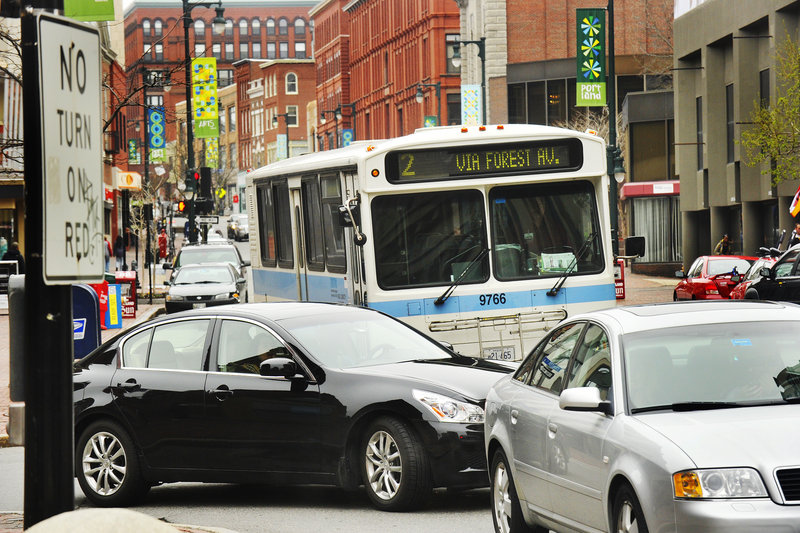PORTLAND – City officials are considering changes to help buses move smoothly through a congested stretch of Congress Street, including having them stop in their lane of traffic while loading and unloading passengers, rather than pulling over.
Other options to keep traffic moving include consolidating bus stops or eliminating some left turns for all traffic, said Bill Needelman, a senior planner with the city who is leading the effort to make the public transit system operate more efficiently in the heart of downtown Portland.
Needelman said consultants who were hired to help with the project noted that Congress Street from Forest Avenue to Elm Street has “a Manhattan-like concentration of buses.”
Every bus in Metro’s system travels on that stretch, he said, and several buses from outlying towns feed into Congress Street.
The city will hold a walking tour today along the portion of Congress Street from Longfellow Square to Franklin Street. The tour will be followed by a forum at 4 p.m. at the Maine College of Art to discuss the issue and solicit the public’s feedback on possible solutions.
Needelman said the study of buses on Congress Street is still in the information-gathering phase; the goal is to get a report done by early summer. At some point, the City Council would likely be asked to approve any steps that are recommended.
Needelman said any recommendations will go through a public process to determine whether the benefits outweigh the drawbacks.
For instance, he said, allowing buses to stop in traffic to pick up and drop off passengers would delay drivers behind them, but it would speed up the buses, whose drivers are delayed when they have to wait for a break in traffic to get back onto Congress Street.
He said few drivers use Congress Street to get across a long stretch of downtown — most are heading to destinations right on or just off Congress Street, so few would be stuck behind a bus for more than a few blocks.
Other solutions also require trade-offs, Needelman said.
Restrictions on left turns might cause drivers to take roundabout routes to destinations, but the restrictions would keep traffic moving. And a reduced number of stops would allow traffic to keep going, but might inconvenience riders.
“We want to improve the bus system, but we also don’t want to discourage people coming to downtown by car, which is the way most people in Maine travel,” said Janis Beitzer, executive director of Portland’s Downtown District, which helps promote the downtown’s interests.
Beitzer said the key is keeping the interests of everyone in mind.
“It is a balancing act, but done right, it may be that it won’t slow cars down,” she said.
Staff Writer Edward D. Murphy can be contacted at 791-6465 or at: emurphy@pressherald.com
Send questions/comments to the editors.




Success. Please wait for the page to reload. If the page does not reload within 5 seconds, please refresh the page.
Enter your email and password to access comments.
Hi, to comment on stories you must . This profile is in addition to your subscription and website login.
Already have a commenting profile? .
Invalid username/password.
Please check your email to confirm and complete your registration.
Only subscribers are eligible to post comments. Please subscribe or login first for digital access. Here’s why.
Use the form below to reset your password. When you've submitted your account email, we will send an email with a reset code.